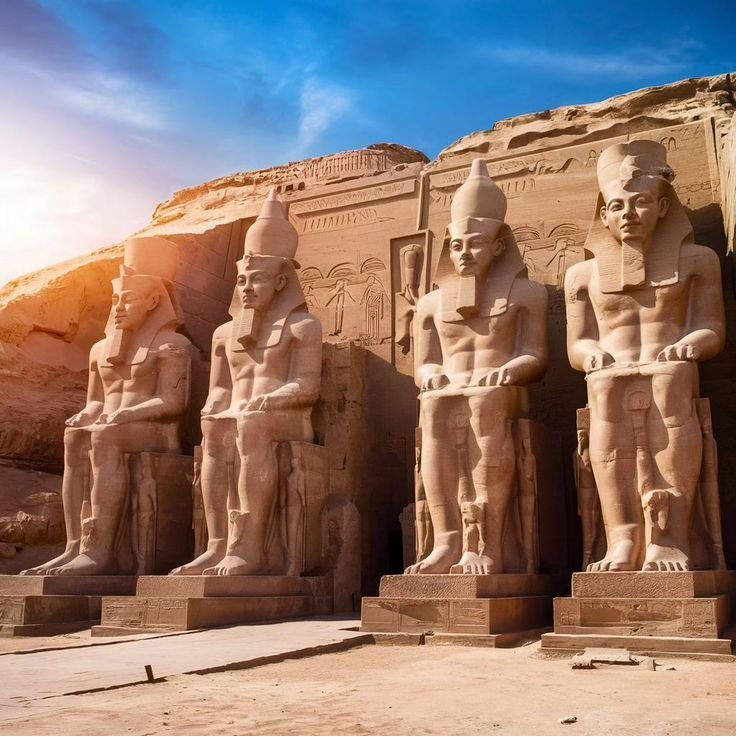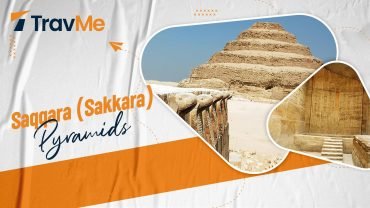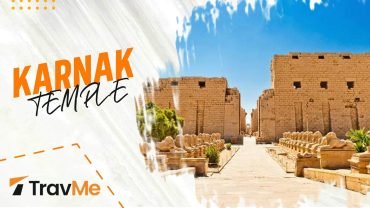The Abu Simbel Temples, Aswan nestled in southern Egypt, stand as a testament to the grandeur and historical significance of ancient Egyptian civilization. Constructed between 1264 and 1244 BCE during the reign of Pharaoh Ramses II, these temples are marvels of architectural ingenuity and artistic excellence. The Abu Simbel complex consists of two monumental temples carved directly into a mountainside on the west bank of the Nile River, near its first and second cataracts. Ramses II, also known as Ramses the Great, built these temples to commemorate his victory at the Battle of Kadesh and to honor the gods and his beloved wife, Queen Nefertari.
The Historical Significance of Abu Simbel Temples

Pharaoh Ramses II, one of ancient Egypt’s most powerful and influential rulers, commissioned the construction of the Abu Simbel Temples. The Great Temple, the largest of the two, is dedicated to the gods Amun, Ra-Horakhty, and Ptah, as well as Ramses II himself. The smaller Temple of Hathor is dedicated to Queen Nefertari and the goddess Hathor. These temples not only symbolize Ramses II’s devotion to the gods and his power but also serve as a testament to Egypt’s architectural and artistic achievements during the New Kingdom period.
THE GREAT TEMPLE STANDS 98 FEET (30 METRES) HIGH WITH FOUR SEATED COLOSSI DEPICTING RAMESSES II FLANKING THE ENTRANCE.
The Great Temple’s facade features four colossal statues of Ramses II, each standing 69 feet (21 meters) tall. These statues are an awe-inspiring sight, representing the pharaoh seated on his throne and flanking the temple’s entrance. The precise alignment of the temple with the sun is one of its most remarkable features. On two specific days each year, October 22 and February 22, sunlight penetrates the temple’s inner sanctuary, illuminating the statues of Ramses II and the gods, a phenomenon believed to commemorate Ramses II’s coronation and birth
Architectural Marvels of Abu Simbel Temples
The Abu Simbel Temples are renowned for their grand scale and intricate carvings. The Great Temple’s facade, with its colossal statues of Ramses II, is just the beginning of the architectural wonders within. The temple’s interior is adorned with stunning bas-reliefs and statues depicting scenes of Ramses II’s military victories, religious rituals, and his relationship with the gods. The craftsmanship and attention to detail in these carvings are extraordinary, showcasing the artistic prowess of ancient Egyptian artisans.
The Temple of Hathor, while small, is equally impressive. Its facade features six statues, four of Ramses II and two of Queen Nefertari, each about 33 feet (10 meters) tall. These statues are set between buttresses carved with hieroglyphs, adding to the temple’s grandeur. Inside, the temple walls are decorated with beautiful carvings and paintings depicting Queen Nefertari in the presence of the gods, highlighting her esteemed status and the pharaoh’s devotion to her.
The precise alignment of the Great Temple with the sun is a testament to the advanced engineering skills of the ancient Egyptians. The twice-yearly illumination of the inner sanctuary, known as the Abu Simbel Sun Festival, is a spectacular event that continues to draw visitors from around the world. This alignment required a deep understanding of astronomy, mathematics, and architecture, further underscoring the ingenuity of ancient Egyptian civilization.
Wonders of Egypt & Nile Cruise – Book Now
Wonders of Egypt 9-day tour is an extensive historic sightseeing package that takes you to some of the most iconic landmarks and historical sites in Egypt.
Visiting Abu Simbel Temples

1. Location and Accessibility
The Abu Simbel Temples, a UNESCO World Heritage Site, stand as a testament to ancient Egyptian ingenuity and artistry near the border with Sudan. These magnificent temples can be reached by air, road, or boat from Aswan, making them a convenient and unforgettable addition to your Egyptian itinerary.
2. Ideal Visit Timing
The intense heat can be a real challenge, so plan your visit to the Abu Simbel Temples during the cooler months, from October to April. This will allow you to fully appreciate the intricate details and expansive carvings that adorn these iconic structures.
3. Unveiling the Secrets: Guided Tours
To gain a deeper understanding of the historical and cultural significance of the Abu Simbel Temples, consider joining a guided tour. Knowledgeable guides can shed light on the fascinating stories behind the carvings and statues, bringing the ancient world to life.
4. A Must-See: The Sound and Light Show
Don’t miss the awe-inspiring Sound and Light Show offered at the Abu Simbel Temples in the evening. This captivating show uses dramatic lighting and narration to bring the history of the temples to life, creating an unforgettable experience.
5. A Testament to Preservation: The Remarkable Relocation Story
One of the most remarkable aspects of the Abu Simbel Temples’ history is their relocation in the 1960s. Due to the construction of the Aswan High Dam, the rising water levels of Lake Nasser threatened to submerge these irreplaceable structures. In a monumental international effort led by UNESCO, the Abu Simbel Temples were saved from destruction. Through a meticulously planned and executed operation, the temples were carefully dismantled and relocated to higher ground, 65 meters above their original site. This awe-inspiring feat of engineering, which took four years to complete, involved meticulously cutting the temples into large blocks and meticulously reassembling them in a way that preserved their original orientation and alignment. The successful relocation of the Abu Simbel Temples stands as a beacon of human achievement in archaeological preservation.
The Cultural Impact of Abu Simbel Temples

The cultural impact of the Abu Simbel Temples extends far beyond their historical and architectural significance. They have become a symbol of Egypt’s rich cultural heritage and a testament to the ingenuity and resilience of ancient Egyptian civilization. The temples attract thousands of visitors each year, contributing significantly to Egypt’s tourism industry. Moreover, the story of their relocation serves as a powerful reminder of the importance of preserving our global heritage for future generations. The Abu Simbel Temples continue to inspire awe and admiration, highlighting the enduring legacy of ancient Egypt.
The Rediscovery of the Abu Simbel Temples
The Abu Simbel Temples were rediscovered in 1813 by Swiss explorer John Lewis Burckhardt after being lost to civilization for centuries. The temples had long been forgotten, with the sands of the desert covering all but the tops of the statues. In 1909, the sands were finally cleared away, revealing the magnificent structures in their entirety. This rediscovery marked the beginning of a new era of appreciation and study of these ancient monuments.
Relocation of Abu Simbel Temples
As a result of the rising waters of the Nile River caused by the construction of the Aswan High Dam, the Abu Simbel Temples were in danger of being submerged. The relocation project, completed between 1964 and 1968, involved dismantling the temples and moving them to a higher location 64 meters above and 180 meters west of their original site. This massive undertaking, directed by UNESCO, involved cutting the temples into pieces weighing between 3 and 20 tons and reassembling them with precision. The relocation of the Abu Simbel Temples is considered one of the most impressive engineering feats in history, preserving these ancient wonders for future generations.
Great Temple
The Great Temple at Abu Simbel, also known as the Temple of Ramses II, took around twenty years to build. Dedicated to the gods Amun, Ra-Horakhty, and Ptah, as well as to Ramses II himself, this temple is considered one of the grandest and most beautiful in Egypt. The entrance is flanked by four colossal statues of Ramses II, each seated on a throne and standing 20 meters tall. The facade is decorated with hieroglyphs that commemorate Ramses II’s great victory at the Battle of Kadesh.
Inside the Great Temple, a series of rooms are dedicated to Ramses II and important members of his family. The innermost sanctuary, or sanctum sanctorum, remains in darkness every day except for two days a year when the sun illuminates it. This phenomenon required a broad knowledge of science, mathematics, architecture, and astronomy to achieve, showcasing the advanced skills of ancient Egyptian engineers and architects.
Small Temple
The Small Temple, also known as the Temple of Hathor and Nefertari, is dedicated to the goddess Hathor and Ramses II’s beloved wife, Queen Nefertari. Although smaller than the Great Temple, it is equally impressive. The facade features six statues, two of Queen Nefertari and four of Ramses II, each standing 10 meters tall. These statues are set between buttresses carved with hieroglyphs, adding to the temple’s grandeur.
Inside, the walls are adorned with beautiful carvings and paintings depicting Queen Nefertari in the presence of the gods. The temple honors her esteemed status and the pharaoh’s devotion to her, highlighting the significance of the queen in ancient Egyptian society.
Adventure Egypt & Felucca – Book Today
Feel the Adventure Sailing on a Felucca from Aswan towards Luxor where you will Explore the amazing natural spots of the river Nile.
Alignment of the Sun with the Temple of Ramses II, Abu Simbel

One of the most fascinating aspects of the Abu Simbel Temples is the alignment of the Great Temple with the sun. Twice a year, on February 22 and October 22, the sun illuminates the innermost sanctuary, lighting up the statues of Ramses II, Ra-Horakhty, and Amun. The fourth statue, representing Ptah, the god of darkness, remains in shadow. This precise alignment is a testament to the advanced astronomical knowledge and engineering skills of the ancient Egyptians.
What is the Abu Simbel Sun Festival?
The Abu Simbel Sun Festival is a biannual event that celebrates the ancient Egyptians’ knowledge and skill in aligning the temple with the sun. Thousands of people from around the world gather at the Abu Simbel Temples on February 22 and October 22 to witness the spectacular illumination of the inner sanctuary. This event is a powerful reminder of the ingenuity and accomplishments of ancient Egyptian civilization.
How to Get to Abu Simbel Temples?
The Abu Simbel Temples are located near the border with Sudan, several hours’ drive south of Aswan. Most tourists arrive by plane, with flights from Aswan taking just 30 minutes. There are two flights a day, allowing visitors about two hours to explore the temples. Alternatively, visitors can join a Lake Nasser cruise, which moors in front of the temples, providing the opportunity to see them by moonlight and in the early morning light.
OPENING HOURS
All Days


Practical Tips for Visitors
Wear Comfortable Clothing: Given the hot climate and the size of the site, comfortable clothing and sturdy walking shoes are essential. Don’t forget a hat and sunscreen to protect yourself from the sun.
Stay Hydrated: Carry a water bottle and stay hydrated throughout your visit. There are limited facilities within the temple complex, so it’s best to come prepared.
Respect the Site: The Abu Simbel Temples are of great historical and cultural significance. Visitors should respect the rules and guidelines set by the authorities, including restrictions on photography and touching ancient structures.
Purchase Tickets in Advance: To avoid long lines and ensure entry, it’s advisable to purchase tickets in advance, especially during peak tourist seasons.
The Abu Simbel Temples are monumental testaments to the grandeur and sophistication of ancient Egyptian civilization. Their historical significance, architectural marvels, and cultural impact make them an essential destination for anyone interested in exploring Egypt’s rich heritage.
TravMe, invites you to explore the rich history, architectural splendor, and cultural significance of the Abu Simbel Temples. Book your Next Trip with TravMe.
Business Information
– Phone: +201008833030
– Fax: +20233765560
– Email: info@travmetours.com
– Address: 5 Zohor St, Hadayek El Ahram, Elite Compound, Remaya Square, Giza, Egypt.
Read More
The Ultimate Guide to Exploring the Pyramids of Giza for 2024 | With Prices
Best Cairo Travel Guide – A Local’s Guide to Visiting Cairo | Updated 2024
Egypt Travel Tips for First-Time Visitors
Best Cairo Travel Guide – A Local’s Guide to Visiting Cairo | Updated 2024





Comment (0)